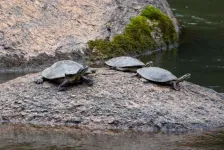(Press-News.org)
A University of Massachusetts Amherst neuroscientist has been awarded a $3.1 million grant from the National Institute of Neurological Disease and Stroke to advance knowledge on human brain development by using an unusual subject: the brain of the sea slug.
This tiny invertebrate is an ideal candidate to study for brain development because it adds a countable number of neurons to its brain – the number increases more than 40-fold in less than eight weeks to a total of about 10,000 neurons – while the animal grows and performs behaviors, explains Paul Katz, professor of biology and director of the UMass Initiative on Neurosciences. This compares to the 100 billion or so neurons in the human brain, a relatively stable number from birth to death, but too many (and with too many connections) to map with existing technology.
By creating a series of complete maps, or connectomes, of every neural connection as the sea slug’s brain develops, the research will shed light on how neurons are added to functional neural circuits.
“Many neurological conditions result from problems arising during development, yet a fundamental understanding of how new neurons are added to growing circuits is lacking,” Katz says. “The results of our research will provide an unprecedented look at how the synaptic networks of neurons across an entire brain change as new neurons are added.”
Collaborating with Jeff Lichtman’s Lab at Harvard University, Katz will study the nudibranch mollusc Berghia stephanieae, a sea slug that is raised in the Katz Lab. Katz has been studying other sea slug species for some three decades but switched to Berghia when he moved to UMass Amherst six years ago.
“The brain [of the sea slug] actually gets bigger as the animal grows older and it adds more neurons, which is not true of you and me,” Katz says. “When humans are born, we have more neurons than when we die. We lose neurons all the time. In fact, selectively pruning neurons and their connections is a normal part of human brain development.”
Katz and team plan to map all of the sea slug’s neurons and their connections – the so-called connectome – as new neurons are added by cutting the brains of the animals at different stages of their development into thousands and thousands of impossibly thin slices, 30 nanometers thick. Using a block-face serial scanning electron microscope housed in the EM core facility at the UMass Institute for Applied Life Sciences (IALS), the researchers will take images of the slices and then reconstruct all of the neurons and their connections at different developmental stages. This massive undertaking will require new methods in machine learning to classify neurons and synapses across samples.
“This undertaking – doing a developmental connectome – was science fiction just five years ago,” Katz says. “And now the technology, the artificial intelligence, is advancing fast enough that we have a prayer. It would have taken a thousand man-years to be able to take those images and put them back together.
“This is a different way to build a brain,” Katz adds. “It’s the only system where you can do this type of analysis of looking to see how neurons are added to a brain over time.”
The researchers will also use single-cell RNA sequencing technology to examine the identity of each neuron. “You bar code each of the cells with a particular tag and then when you sequence the RNA, all of the RNA from each single cell is separate. So you’re learning which genes each cell is expressing,” Katz explains.
Developmental connectomes have been constructed in only two other animals: the nematode worm, C. elegans, which does not add neurons as it grows; and the fruit fly, Drosophila melanogaster, which undergoes metamorphosis from larva to adult, so the larval nervous system is rearranged. The sea slug differs from these examples because neurons are constantly being added as the animal grows larger.
The research is an important step toward understanding human brain development.
“What we hope to learn are the rules – how does this happen?” Katz says. “We’re exploring in order to figure out what questions to ask in more complicated systems.”
END
North Carolina State University researchers have successfully transferred an important gene from one compartment of a plant cell to another to produce tobacco plants that lack pollen and viable seeds, while otherwise growing normally. Their findings could lead to better ways of producing hybrid seeds to maximize crop productivity, or to introduce seedlessness in fruit species lacking the often-desired trait, such as raspberries, blackberries or muscadine grapes.
The researchers began the work in the energy-producing portion of a cell, the mitochondria. In plants, aberrations within the mitochondrial genome can be associated with ...
A research project supported by FAPESP shows that the construction of new hydroelectric power plants in Brazil’s South region could have an impact on more than 30% of the habitat of Phrynops williamsi, the Williams’ side-necked turtle. The species occurs only in areas of Atlantic Rainforest and Pampa (the grassland biome adjacent to Brazil’s border with Uruguay and Argentina), and is classed as “Vulnerable” (facing a high risk of extinction) by the International Union for Conservation of Nature (IUCN).
An article on the study is published in the Journal of Applied Ecology by ...
(BOSTON)—The National Institutes of Health/National Institute on Aging recently awarded a $13.7 million grant to a project led by Boston University Chobanian & Avedisian School of Medicine principal investigators Lindsay Farrer, PhD, chief of biomedical genetics and distinguished professor of genetics, and Richard Sherva, PhD, assistant professor of medicine in biomedical genetics, for research using whole genome sequencing and other approaches to identify genetic factors for Alzheimer disease (AD) in Jews currently living in ...
WEST LAFAYETTE, Ind. – A Purdue researcher is taking a giant leap forward in the fight against drug-resistant strains of malaria in developing countries.
Open Philanthropy has awarded $1.38 million to Philip Low to further validate a drug therapy that he and his colleagues have previously shown to successfully treat the disease. Low (rhymes with “now”) is Purdue University’s Presidential Scholar for Drug Discovery and the Ralph C. Corley Distinguished Professor of Chemistry in the College of Science.
For years, experts ...
CHAMPAIGN, Ill. — New research led by data science experts at the University of Illinois Urbana-Champaign and United Nations Global Pulse found that there is no strong evidence that YouTube promoted anti-vaccine sentiment during the COVID-19 pandemic.
The study, published in the Journal of Medical Internet Research, performed an algorithmic audit to examine if YouTube’s recommendation system acted as a “rabbit hole,” leading users searching for vaccine-related videos to anti-vaccine content.
For the study, the researchers asked World Health Organization-trained participants and workers from Amazon Mechanical Turk to intentionally ...
A team of scientists, led by researchers at UCL, have developed new methods to predict outcomes for pregnancies where there are issues with poor growth of the baby inside the womb.
The research, published in the Journal of Clinical Investigation, involved 142 women from the EVERREST Prospective Study* who had severe early-onset fetal growth restriction (FGR) – meaning their babies were very small on ultrasound scans early in the second half of pregnancy (between 20 and 27 weeks).
Fetal growth restriction affects approximately ...
Sage offers journalists free access to the articles in all of our 1,100 journals upon request. You can submit your request via this form or contact pr@sagepub.co.uk for more information.
Sage also provides paywall-free links to the Sage articles journalists cite so the audience can read the underlying scholarship for free. To get a paywall-free link to an article in Sage journals, please email pr@sagepub.co.uk with the name of the article and the journal one business day ahead of the publication of the article.
Sage has pledged to improve access to our research both to bridge ...
Health systems science is an emerging field that focuses on how care is delivered, how health professionals collaborate, and how the health system can improve patient care and health care delivery. The Virginia Tech Carilion School of Medicine (VTCSOM) is a leader in both its education and its research in health systems science. Both are evident in two recently awarded grants from the American Medical Association to study ways to enhance health systems science education, one at the medical education ...
In a new study published on 26 July 2023, in the journal Environmental Science and Ecotechnology, researchers from Harbin Institute of Technology, have developed a novel double Z-scheme photocatalyst, called the molecularly imprinted TiO2@Fe2O3@g-C3N4 (MFTC) composite, that selectively removes SMX from water.
Traditional photocatalytic methods have faced challenges with selectivity, often causing the indiscriminate degradation of organic pollutants and coexisting contaminants at high concentrations. However, the MFTC composite was purposefully designed to overcome this limitation by incorporating molecularly imprinted sites on its surface. These specialized ...
About The Study: The findings of this study of 44,000 low-income, working-age adults suggest that the direct cost of providing public health insurance to immigrants is less than that for the U.S. born, and immigrants’ health care utilization, upon coverage, remains comparatively modest, thus refuting the notion that providing insurance to immigrants imposes a heavy fiscal burden.
Authors: Felix M. Muchomba, Ph.D., of the State University of New Jersey in New Brunswick, is the corresponding author.
To access the embargoed study: Visit our For The Media website at this link https://media.jamanetwork.com/
(doi:10.1001/jamanetworkopen.2023.34008)
Editor’s ...







